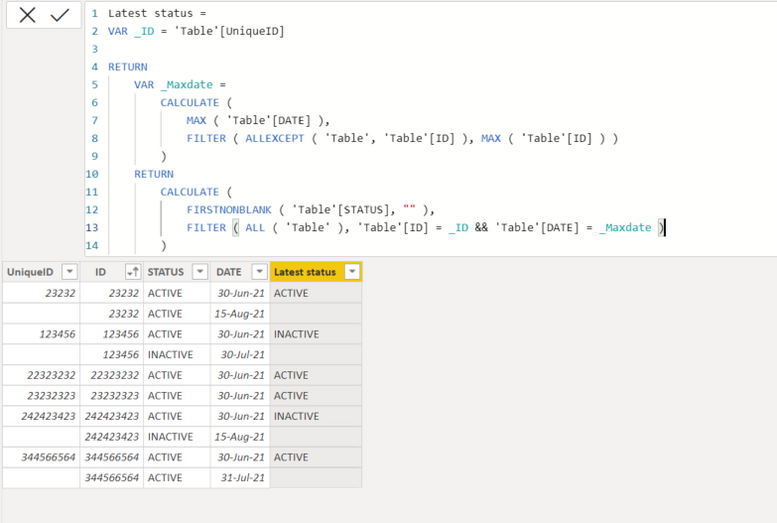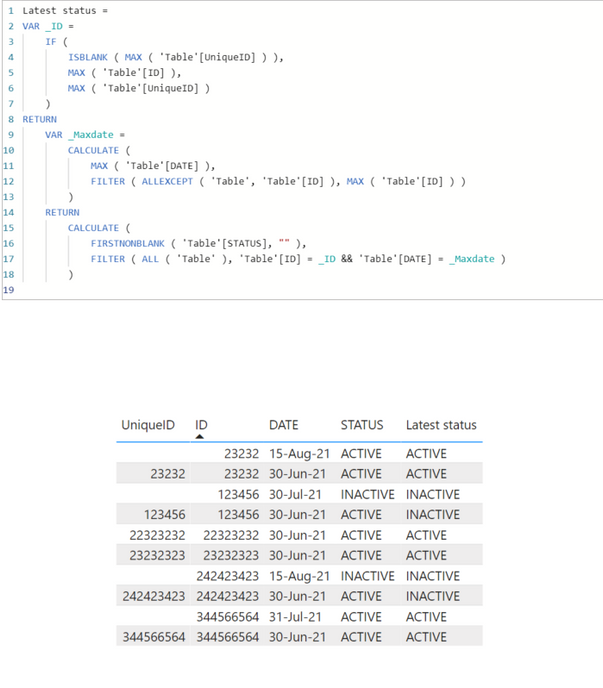Join us at FabCon Vienna from September 15-18, 2025
The ultimate Fabric, Power BI, SQL, and AI community-led learning event. Save €200 with code FABCOMM.
Get registered- Power BI forums
- Get Help with Power BI
- Desktop
- Service
- Report Server
- Power Query
- Mobile Apps
- Developer
- DAX Commands and Tips
- Custom Visuals Development Discussion
- Health and Life Sciences
- Power BI Spanish forums
- Translated Spanish Desktop
- Training and Consulting
- Instructor Led Training
- Dashboard in a Day for Women, by Women
- Galleries
- Data Stories Gallery
- Themes Gallery
- Contests Gallery
- Quick Measures Gallery
- Notebook Gallery
- Translytical Task Flow Gallery
- TMDL Gallery
- R Script Showcase
- Webinars and Video Gallery
- Ideas
- Custom Visuals Ideas (read-only)
- Issues
- Issues
- Events
- Upcoming Events
Enhance your career with this limited time 50% discount on Fabric and Power BI exams. Ends September 15. Request your voucher.
- Power BI forums
- Forums
- Get Help with Power BI
- Desktop
- Need help with power query or DAX formula
- Subscribe to RSS Feed
- Mark Topic as New
- Mark Topic as Read
- Float this Topic for Current User
- Bookmark
- Subscribe
- Printer Friendly Page
- Mark as New
- Bookmark
- Subscribe
- Mute
- Subscribe to RSS Feed
- Permalink
- Report Inappropriate Content
Need help with power query or DAX formula
Hi,
I have 4 columns in a table.
First Column is a unique ID, Second column is the ID (same as first column but has multiple entries),
thrid column is the status and fourth column is date.
I need to take the unique ID, compare and filter the second column. If there are multiple values then I need the status of the latest date and print it in a new fifth column.
| UniqueID | ID | STATUS | DATE |
| 123456 | 123456 | ACTIVE | 30-Jun-21 |
| 344566564 | 344566564 | ACTIVE | 30-Jun-21 |
| 242423423 | 242423423 | ACTIVE | 30-Jun-21 |
| 23232 | 23232 | ACTIVE | 30-Jun-21 |
| 22323232 | 22323232 | ACTIVE | 30-Jun-21 |
| 23232323 | 23232323 | ACTIVE | 30-Jun-21 |
| 123456 | INACTIVE | 30-Jul-21 | |
| 344566564 | ACTIVE | 31-Jul-21 | |
| 242423423 | INACTIVE | 15-Aug-21 | |
| 23232 | ACTIVE | 15-Aug-21 |
Can you please help me to achieve the result. Thank you
Solved! Go to Solution.
- Mark as New
- Bookmark
- Subscribe
- Mute
- Subscribe to RSS Feed
- Permalink
- Report Inappropriate Content
Hi @manipepsi ,
Please try to deal with it in Power Query Editor with the below applied codes and check whether you still get the errpr message with "there is no enough memory"... You can find the details in the attachment.
let
Source = Table.FromRows(Json.Document(Binary.Decompress(Binary.FromText("i45WMjQyNjE1U9JBMBydQzzDXIEMYwNdr9I8XSNDpVidaCVjE6C0mamZCUgGiY1DuZEJEBoDEVAGmY1LuTEQgpRCaVzKwPIQlQgmPjONIS5AMHEoRg4BTz9URTlIirB73RBNFbKPkUwzNNV1LE1HVofuAyQVsQA=", BinaryEncoding.Base64), Compression.Deflate)), let _t = ((type nullable text) meta [Serialized.Text = true]) in type table [UniqueID = _t, ID = _t, STATUS = _t, DATE = _t]),
#"Changed Type" = Table.TransformColumnTypes(Source,{{"UniqueID", Int64.Type}, {"ID", Int64.Type}, {"STATUS", type text}, {"DATE", type date}}),
#"Grouped Rows" = Table.Group(#"Changed Type", {"ID"}, {{"Latest date", each List.Max([DATE]), type nullable date}, {"Details", each _, type table [UniqueID=nullable number, ID=nullable number, STATUS=nullable text, DATE=nullable date]}}),
#"Expanded Details" = Table.ExpandTableColumn(#"Grouped Rows", "Details", {"UniqueID", "STATUS", "DATE"}, {"UniqueID", "STATUS", "DATE"}),
#"Added Custom" = Table.AddColumn(#"Expanded Details", "Latest Status", each if [DATE]=[Latest date] then [STATUS] else null),
#"Removed Columns" = Table.RemoveColumns(#"Added Custom",{"Latest date"})
in
#"Removed Columns"The detailed steps as below:
1. Get the latest date group by ID and expand the details
2. Add conditional column to get the status with latest date
3. Remove the latest date column
Best Regards
- Mark as New
- Bookmark
- Subscribe
- Mute
- Subscribe to RSS Feed
- Permalink
- Report Inappropriate Content
Hi @manipepsi ,
Please try to deal with it in Power Query Editor with the below applied codes and check whether you still get the errpr message with "there is no enough memory"... You can find the details in the attachment.
let
Source = Table.FromRows(Json.Document(Binary.Decompress(Binary.FromText("i45WMjQyNjE1U9JBMBydQzzDXIEMYwNdr9I8XSNDpVidaCVjE6C0mamZCUgGiY1DuZEJEBoDEVAGmY1LuTEQgpRCaVzKwPIQlQgmPjONIS5AMHEoRg4BTz9URTlIirB73RBNFbKPkUwzNNV1LE1HVofuAyQVsQA=", BinaryEncoding.Base64), Compression.Deflate)), let _t = ((type nullable text) meta [Serialized.Text = true]) in type table [UniqueID = _t, ID = _t, STATUS = _t, DATE = _t]),
#"Changed Type" = Table.TransformColumnTypes(Source,{{"UniqueID", Int64.Type}, {"ID", Int64.Type}, {"STATUS", type text}, {"DATE", type date}}),
#"Grouped Rows" = Table.Group(#"Changed Type", {"ID"}, {{"Latest date", each List.Max([DATE]), type nullable date}, {"Details", each _, type table [UniqueID=nullable number, ID=nullable number, STATUS=nullable text, DATE=nullable date]}}),
#"Expanded Details" = Table.ExpandTableColumn(#"Grouped Rows", "Details", {"UniqueID", "STATUS", "DATE"}, {"UniqueID", "STATUS", "DATE"}),
#"Added Custom" = Table.AddColumn(#"Expanded Details", "Latest Status", each if [DATE]=[Latest date] then [STATUS] else null),
#"Removed Columns" = Table.RemoveColumns(#"Added Custom",{"Latest date"})
in
#"Removed Columns"The detailed steps as below:
1. Get the latest date group by ID and expand the details
2. Add conditional column to get the status with latest date
3. Remove the latest date column
Best Regards
- Mark as New
- Bookmark
- Subscribe
- Mute
- Subscribe to RSS Feed
- Permalink
- Report Inappropriate Content
Hi @Anonymous
Thanks for your help.
Your solution fullfilled my need.
Thank you!
- Mark as New
- Bookmark
- Subscribe
- Mute
- Subscribe to RSS Feed
- Permalink
- Report Inappropriate Content
Thanks @VahidDM for the quick reply.
I have still 2 questions:
1) In the "Latest Status" whether it is possible to have the latest status (Inactive, active etc.) only for "Unique ID" ?
Meaning: What I need is the latest status for every Unique ID so that I can filter the latest statuses which I need.
In this solution I cannot able to filter 2 statuses and get the unique IDs of those.
2) Whether it is possible to have "Latest Status" as a column and not as a measure?
Can you please also help with these questions?
Thanks in advance!!
- Mark as New
- Bookmark
- Subscribe
- Mute
- Subscribe to RSS Feed
- Permalink
- Report Inappropriate Content
Hi @manipepsi
Yes, It is.
Add a new column and try the below measure:
Latest status =
VAR _ID = 'Table'[UniqueID]
RETURN
VAR _Maxdate =
CALCULATE (
MAX ( 'Table'[DATE] ),
FILTER ( ALLEXCEPT ( 'Table', 'Table'[ID] ), MAX ( 'Table'[ID] ) )
)
RETURN
CALCULATE (
FIRSTNONBLANK ( 'Table'[STATUS], "" ),
FILTER ( ALL ( 'Table' ), 'Table'[ID] = _ID && 'Table'[DATE] = _Maxdate )
)The output will be as below:
Did I answer your question? Mark my post as a solution!
Appreciate your Kudos !!
- Mark as New
- Bookmark
- Subscribe
- Mute
- Subscribe to RSS Feed
- Permalink
- Report Inappropriate Content
HI @VahidDM
Thanks for your quick response.
I tried your solution but I got the error "There is no enough memory to complete this operation" .
I have 16GB of RAM but my data has 300K rows.
Whether there is any possibility to have a memory efficient solution?
Thank you
- Mark as New
- Bookmark
- Subscribe
- Mute
- Subscribe to RSS Feed
- Permalink
- Report Inappropriate Content
Hi @manipepsi
Please try this measure:
Latest status =
VAR _ID =
IF (
ISBLANK ( MAX ( 'Table'[UniqueID] ) ),
MAX ( 'Table'[ID] ),
MAX ( 'Table'[UniqueID] )
)
RETURN
VAR _Maxdate =
CALCULATE (
MAX ( 'Table'[DATE] ),
FILTER ( ALLEXCEPT ( 'Table', 'Table'[ID] ), MAX ( 'Table'[ID] ) )
)
RETURN
CALCULATE (
FIRSTNONBLANK ( 'Table'[STATUS], "" ),
FILTER ( ALL ( 'Table' ), 'Table'[ID] = _ID && 'Table'[DATE] = _Maxdate )
)the output will be as below:
Did I answer your question? Mark my post as a solution!
Appreciate your Kudos !!
Helpful resources
| User | Count |
|---|---|
| 68 | |
| 63 | |
| 59 | |
| 54 | |
| 28 |
| User | Count |
|---|---|
| 182 | |
| 81 | |
| 64 | |
| 46 | |
| 38 |







